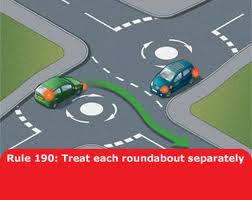Driving instructor vacancies in Basildon
- Jul 08, 2019
V ery simply, roundabouts allow traffic from different roads to merge or cross as any junction, but without necessarily stopping.
The view on approach to most roundabouts is typically open which will tend to mean that you can look for gaps in traffic which will allow you to continue if safe.
'Roundabouts' is a little misleading as the road layout is variable with regards to size and particularly shape. i.e. The junction is not always circular.
Basic rules
You need to consider, you normally give way to any traffic approaching from your immediate right as those vehicles have priority.
The traffic flow is in one direction as guided by signs, and in all cases, vehicles Must pass round the central markings except when you are physically incapable of doing so.
Exceptions
Like most of driving, there are grey areas or exceptions to the basic rules.
It is important to always apply the LMSPSL routine on the approach with importance being placed on the LOOK element.
Roundabouts can be particularly hazardous areas so it is important to always look well ahead for the advance warning sign.
The advanced warning sign and especially the roundabout direction sign will give you a clear picture of the complexity of the road layout of the roundabout, as well as route directions. Usually, road markings on the approach and/or on the roundabout will support the direction signs.
If vehicles are covering the road markings then drop back to allow time to read the markings or be guided by the signals those vehicles are giving as this may help to determine where each lane is intended.
As a result you will be able to select the most appropriate lane for your journey. It is vitally important to get into the correct lane in good time to help other road users know where you are going.
Try to avoid straddling lanes as this could cause confusion or in the worst case scenario lead to a collision.
If you find yourself in the wrong lane, avoid changing lanes at the last moment, simply continue in the direction you are heading or be prepared to circle the roundabout again, it's usually the safest option.
Procedure
The procedure for roundabouts follows the LMSPSL routine typical to any hazard or junction. However, you will always need to be guided by signs as mentioned earlier as alternatives to the norm may be necessary.
Through early observation you will know where you need to position, speed limits but you must also consider the size of the roundabout and traffic flow to determine your approach speed.
Although many people consider that you should always select 2nd gear on the approach to a roundabout this is not true as the speed and indeed gear choice is always based on what you see.
Just like all aspects of driving, try to be selective with your gear choice as this will allow you to be in more control and spend more time concentration on the roundabout.
Contrary to popular opinion, gears may be changed on the roundabout itself as long as it's necessary and you have control of the steering. This is based on the size of the junction and usually as you enter and exit you are actually in a straight line which allows for a controlled gear change.

Going left
Going ahead
Going right or full circle
More than three lanes
Where there are more than three lanes at the approach to a roundabout, use the most appropriate lane on approach and through the roundabout.
On the roundabout itself, you may need to move across the lanes earlier than previously mentioned. Although always be guided by road markings and follow the same procedure.
Defensive Driving
Roundabouts are notorious for accidents, especially 'rear end collisions. Always keep an eye on the vehicle in front as your about to enter the roundabout. Don't assume that the driver will keep going as they might stop while you're looking to the right. Many rear end collisions happen this way.
Make sure the vehicle has actually moved and you have space to move into.
Mini roundabouts
Approach these in the same way as a normal roundabout as the same rules apply. Remember there is less space to manoeuvre and less time to signal. For example, when following the road ahead and it's the 2nd exit you intend to take, a signal is not necessary.
You Must pass round the central road marking unless you are driving a large vehicle or towing a trailer which is physically incapable of doing so. It is common practice for many road users these days to pass on the wrong side of the island; this is both illegal and dangerous. Very simply the road marking is placed to keep road users apart.
Be prepared for vehicles to go full circle around the roundabout which can be difficult on smaller junctions. This may mean an adjustment so look out for their signals, speed and position to help you to anticipate their intentions.

Some complexes have double mini roundabouts. Treat these separately and always give way to the right of each roundabout. Here it's important to take effective observation, including looking across to see available gaps and for traffic that may block the immediate right. This may allow enough time for you to make a move.